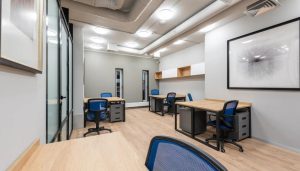Table of Contents
In today’s fast-paced business environment, the design of a workspace holds more significance than ever before. More than just a place to conduct business, it reflects the company’s culture, ethos, and commitment to fostering creativity and collaboration. Recent studies have consistently shown a direct correlation between workspace design and team productivity. An intelligently curated space not only enhances the team’s efficiency but also bolsters their sense of belonging and purpose.
However, striking the right balance in office design can be a nuanced task. It’s not merely about aesthetics or having the latest tech. Instead, it’s about creating an atmosphere that resonates with every individual, ensuring that they can seamlessly transition between teamwork and focused individual tasks, all while feeling invigorated and valued.
Collaborative Corners – Designing Workspaces that Foster Teamwork
The Magic Behind Teamwork
There’s a certain energy that emanates from a room filled with dynamic interactions, brainstorming sessions, and spontaneous exchanges. It’s almost palpable, the electric charge of ideas flying across the room, being moulded, reshaped, and elevated by diverse perspectives. This isn’t just about teamwork; it’s about the setting that nurtures such vibrant collaborations. An environment that understands and prioritises human connectivity lays the foundation for magic to happen.

Yet, fostering this magic isn’t mere happenstance. It’s a well-choreographed dance between design, ambience, and function. Spaces that are too cramped may stifle creativity, while those too expansive can feel impersonal. The key is to infuse a sense of purpose into every nook and cranny. Whether it’s an ergonomic leather office chair that offers comfort during those long brainstorming sessions or adjustable lighting that sets the mood, every element plays its part in kindling the spirit of teamwork.
Elements of a Collaborative Workspace
The ingredients for a perfect collaborative workspace are varied yet harmonious. Natural light, for instance, doesn’t merely offer room brightness but can dramatically uplift moods, enhancing both creativity and productivity. On the other hand, modular furniture, with its adaptability, empowers teams to customise their environment as per the task at hand. One day, a space might be a hub for a team meeting; the next, it could be a quiet spot for focused individual work.
One element often overlooked in its importance is seating. A leather office chair, while symbolising luxury, also signifies attention to ergonomic details. A comfortable chair supports prolonged periods of concentration and collaboration, ensuring that team members remain refreshed and free from physical strain. Every piece of furniture, every window, and even the type of lighting chosen sends a message about the value placed on collaboration and the well-being of team members.
The Importance of Flexibility in Office Design
The ever-evolving nature of business demands spaces that are equally adaptable. A static, unchanging environment can quickly become stifling, limiting the potential for growth and innovation. Enter flexible office design—a concept that champions modularity and adaptability. From movable partitions to height-adjustable tables, the essence lies in ensuring that the space can morph as per the team’s requirements.

It’s about creating a dynamic environment where change is not just welcome but is an integral part of the design. Imagine the freedom to reconfigure a meeting area into individual workstations or even a relaxation zone. It’s not always about grand overhauls; sometimes, a simple act of shifting a leather office chair or rearranging desks can breathe new life into a workspace. A flexible design approach prioritises function and fluidity, ensuring that the work environment remains in sync with the team’s evolving needs.
Integrating Technology for Seamless Teamwork
In the digital age, technology serves as the backbone for effective collaboration. The beauty of modern tech tools is their ability to foster connections, whether team members are sitting across the table or across continents. However, the true challenge lies in integrating these tools into the workspace design without making them obtrusive. Wireless charging tables, embedded screens for video conferencing, and smart lighting systems can augment the collaborative spirit without overwhelming the aesthetics.
But technology isn’t just about flashy gadgets. It’s about understanding the team’s unique needs and weaving tech solutions into their daily routines. Perhaps it’s software that aids in real-time project collaboration or a high-quality sound system for those virtual team meetings. By seamlessly blending technology with design, workspaces can truly cater to the multifaceted requirements of today’s dynamic teams, ensuring both productivity and connectivity.
Tips for Keeping Collaboration Fresh and Exciting
Collaborative spaces, though brimming with energy, can also fall into a rut if not regularly refreshed. The dynamism of collaboration is its ever-evolving nature, and workspaces need to reflect that fluidity. Regular feedback sessions can offer invaluable insights into what’s working and what needs a revamp. Perhaps the cosy corner with the plush leather office chair needs a new plant, or maybe the brainstorming room requires a fresh coat of invigorating paint.

It’s equally important to introduce new collaborative rituals or activities. Monthly team-building exercises, workshops, or even simple changes in team seating arrangements can provide a fresh perspective. By ensuring that the collaborative space is as dynamic as the team it serves, businesses can nurture an environment of continuous growth, innovation, and excitement.
Mistakes to Avoid in Designing Collaborative Workspaces
With the rising popularity of collaborative workspaces, there’s a temptation to jump on the bandwagon without fully grasping its nuances. One of the common pitfalls is overcomplicating designs. Simplicity often breeds clarity, and an overly ornate space can detract from its primary function: Improve teamwork. Acoustics is another overlooked aspect. While open spaces are great for interaction, they can become a nightmare if not acoustically balanced.
Equating luxury with functionality is another common misconception. While a plush leather office chair screams opulence, it’s vital to ensure that it’s also ergonomic and suits the needs of the team. Likewise, merely cramming a room with the latest digital tools doesn’t guarantee enhanced collaboration. It’s essential to discern which tools genuinely augment teamwork and which are mere distractions. By being aware of these missteps and designing with intentionality, one can curate a collaborative space that truly serves its purpose.


